Bastille Day ! The Lafayette class were the last French Frigates designed in the Cold War, with a construction which started in 1990 and five completed until 2001, all active today and modernized. Their specificity was to embrace fully the stealthy characteristics we are all familiar today. Designed and built at DCN, they were medium-sized (3000t) and versatile, and turned to be well adapted to the post-cold war low intensity conflicts, having only defensive SAMs and SSMs and no VLS. The design made quite a splash internationally and led to the adoption of such features in virtually all modern constructions. The Lafayette class earned further orders to DCN, such as the well modified Saudi Al Riyadh class, Taiwanese Kang Ding class and Singaporean Formidable class.
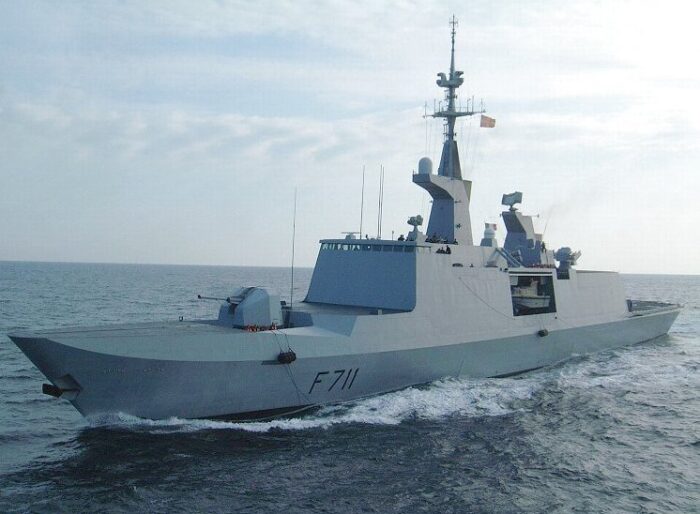
Development
The La Fayette class were started as the FL-3000 program for “Frégate Légère, 3,000 tonnes” or FLF (“Frégate Légère, Furtive”) later as the programme evolved. They were planned initially in 1987 as a class of general purpose frigates, notably to replace ageing Frigates such as the Estiennes D’Orves class (1973). Initially stealth features were an afterthought, they were designed first and foremost as very modular ships able to perform and wide range of missions, as by that stage, the Cold War was still ongoing and did not show signs of abating any time soon. However, requirements on frigates were less stringent for high intensity as destroyers, and they were not envisioned to escort the future PA1 (Charles de Gaulle) in construction. Rather, they were intended to cover a large variety of role and freeing large frigates (or destroyers) for fleet or task force escort missions. They were still well-rounded enough to operate alone and react to numerous fluid situations and scenarios.
As the design progressed from 1987, studies for low-intensity conflicts led to a design well adapted to the needs of the extensive French exclusive economic zone (EEZ), able to perform humanitarian operations, support of land troops, and ultimately replace the D’Estienne d’Orves-class avisos, that proved ill-suited for joint operations.
Indeed, using conventional, high intensity warships for low-intensity or humanitarian operations proved costly between their heavy equipment and large crew so the requirement called for a lightly armed frigates with economical engines, small crew.
In Italy, for the Marina Militare, similar requirements led to build the Cassiopea and Minerva type corvettes, mixing civilian and military standards to make them cheaper. However they were limited to just 1,300 tonnes which was adequate for the Mediterranean and shore operations. The French Navy however had a large part of its EEZ also spread between Pacific and Indian Ocean, and distances to cover were far larger as a result. So to reach endurance and range requirements, the design was raised to 3,000 tonnes, too large for an “aviso” and reaching the rank of a frigate. Strong firepower was kept as well as an helicopter capacity, while keeping a good seaworthiness.
The program in fact was split in the Marine Nationale, leading also to the simpler, cheaper, and civilian standard built Floréal-class frigates, which an even more limited armament, while still being capable of operating a medium helicopter. These were designed for overseas territories, Caribbean, Polynesia, New Caledonia with a top speed limited to just 20 knots (37 km/h; 23 mph) due to the all-diesel solution for better autonomy and reliability. Piracy and smuggling operations required to have two fast rigid-hulled inflatable boats (RHIBs) ready at all time for boarding and control actions. There was also a marine detachment well-trained to these operations.
However, the Marine Nationale also still had a niche for such a ship that could still answer more hostile environments, as an insurance, which became the larger La Fayette type. They were designed to operate in the Indian Ocean or Djibouti, both securing the EEZ, but operating in combat groups at sea, gathering intel and supporting fleet operations. They drew from the C.70 class frigates, for which the class, initially of 20 ships, was cut down to only nine (Georges Leygues/Cassard-class). Their experience ledo a general downsizing and reorganisation of naval capabilities. But DCN, the master yard tasked of the design, came out with a novel idea to answer the high intensity side of the design. And it was naval stealth (“furtivité”), which was worked out in the 1980s. By the time, the F117 night hawk and other stealthy aviation projects were well known and already proven. Soon the B2 spirit would also enter service. However, in 1987-88 it was still new territory as far as naval matters went.
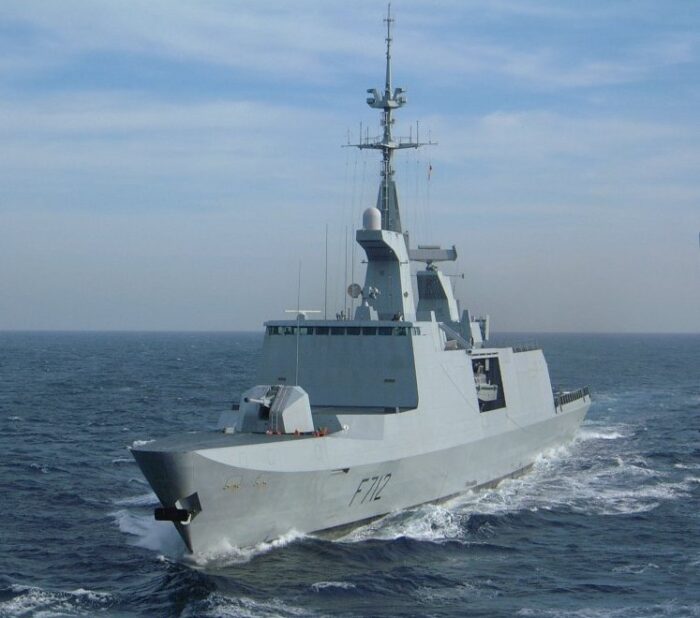
France was not the only one working on this, the US Arleigh Burke class, also designed at that time, also was to included stealthy features. However, it was still new for frigates, especially of taken to the extreme, as DCN proposed. It took several years to refine the sltealthy concept until 1990 when construction was approved after the design was finalized.
Ultimately, the first ship was laid down at DCN on 15 December 1990, so technically months before the end of the cold war. She was launched in 1992, and her weapon system testing happened in 1994, extensive trials notably to prove the new structure’s at sea stress tolerances and a wide array of sea conditions. She was named after Gilbert Du Motier de La Fayette, the young Marquis and general of the continental Army under George Washington as well as later in life an important figure of the French Revolution. Furthermore, she was eventually commissioned in March 1996 and already starring in James Bond’s GoldenEye (1997). Five others (as sixth was cancelled) followed at the same DCN yard, under the main roofed dockyard, large enough for two, until 1999, Guepratte.
In between, six Floréal class Frigates were built in the civilian yard of St Nazaire, commissioned sooner in 1992-94 due to their simplicity. They represented the lower end of the spectrum, and proved perfectly able to patrol the EEZ at a much cheaper cost as intended. However, the “low intensity conflict” requirement for the Lafayette class returned to haunt them in the latter 2000s, especially given their lack of sonar and weak air defence capabilities. With the return of high intensity since the 2002 invasion of Ukraine, there are plans to rebuild them, notably ot integrate the aster missile, possibly in a VLS, albeit the cost of such refit is a daunting prospect. Since 1992, France completely embraced the stealth concept for all its fleet, notably the FREMM class destroyer at the high end (made with Italy, a design adopted by the USN for the Constellation class), and the Aquitaine class Frigates, more capable than the Lafayette, until todays DFI (Ronarch class), smaller than the Lafayette yet far more capable.
Design of the class
Specifics of the design
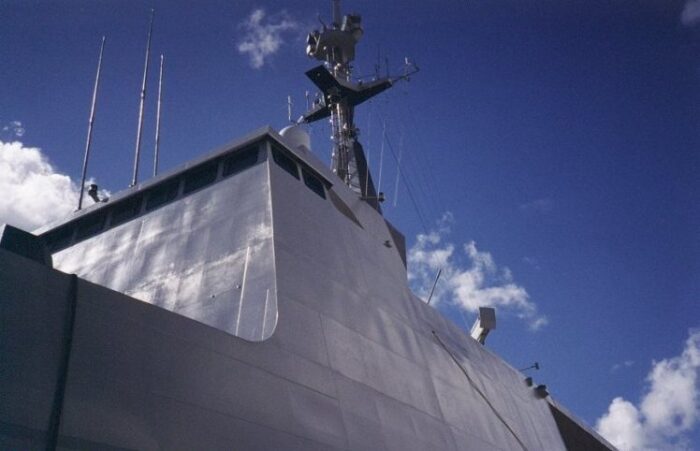
Aconit showing her very pure lines. The composite and steel panels are covered with a radar-absorbent material
The focus point of DCN efforts, shaping the hull, was of course something ported to the extreme. Lafayette when commissioned had pushed what was possible in terms of stealthy shapes. Her hull and superstructures were monobloc in appearance, made for an optimal reduction of radar signature, without leaving anything external on which radar waves can bounce back. Stealth though inclined flanks, very few vertical lines, very clean lines and superstructures with all stairs and mooring equipment remaining internal, prominent structures covered by clear surfaces with only a small opening amidship for a RHIB which itself could be covered by a curtain. In addition, these surfaced were covered with radar-absorbent synthetic materials.
DNC declare her radar cross-section was that of a large trawler, so to be camouflaged among civilian ships and make belief of the presence of a much smaller corvette, making underestimate her capabilities. It could also be used to evade enemy missiles or fire control systems. This passive aspect was completed by macks in which the engine exhausts were brassed with an influx of cold air before exiting to reduce infrared signature. There was an active aspect to this protection, with jammers designed to generate false radar images and trusted decoy launchers in last recourse.
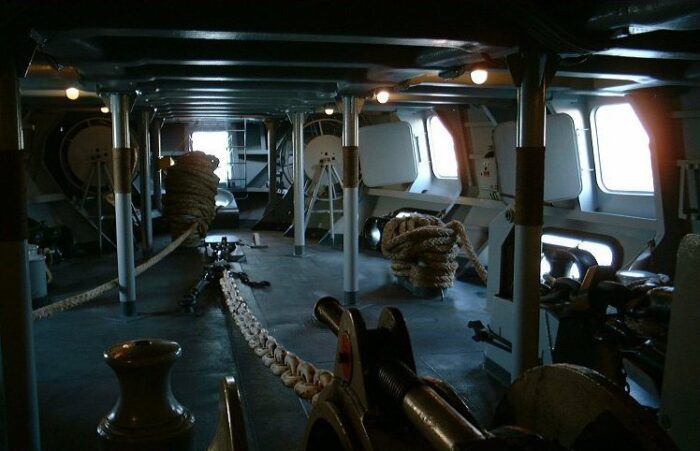
The forecastle deck is completely encased below a light structure for stealth.
Another key difference, both for her or the Floréal class frigates, was the adoption of low-power diesel motors to make the special heat dissipation system even more efficient. This was an issue unlike a gas turbine for speed, but that was not a requirement. The result was that the La Fayette class have a low thermal signature. Dissipation is helped by small sets of pipes aft of the mast cooling exit gas before released. Plus, as they are designed to operate in warm areas, the thermal contrast starts to blend with the environment.
Effort were also put to reduce her magnetic signature by using composite materials whenever possible and use a demagnetisation belt.
There was at last the acoustic signature question: By mounting all diesel engines on elastomeric supports, very little vibration was transferred into the hull. This was enhanced further by having rubber coatings on the propellers. The La Fayette class were also the first French ships equipped with the new US Prairie Masker active acoustic camouflage system, generating small bubbles from underneath the hull in order to confuse sonars.
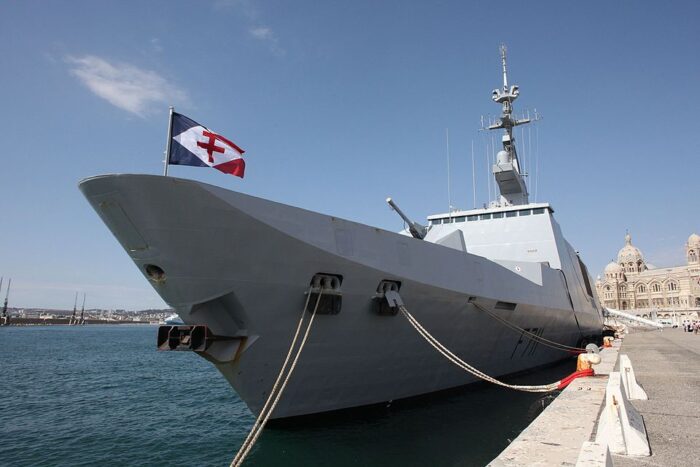
Hull and general design
The Lafayette class were medium-sized frigates, displacing 3,200 t (3,100 long tons; 3,500 short tons) light as built and 3,800 t (3,700 long tons; 4,200 short tons) fully loaded in service order. The hull was relatively small at 125 m (410 ft 1 in) long overall for a beam of 15.4 m (50 ft 6 in) helping for stability but less for speed, and a moderate draught of 4.1 m (13 ft 5 in) helping her to enter most inland waterways. The construction by DCN mixed for the superstructure light alloy and glass-reinforced plastic, reducing top weight but not decreasing much the risk of fire. Vital zones received Kevlar such as the ammunition magazines and command centre deep in the ship, and all important systems are redundant. The hull is also well protected externally and made NBC proof, with the crew protected against biological, chemical, and nuclear environments by a full suite comprising air conditioning, overpressure, detectors, full sealing and lining, and sprinklers to wash up the hull externally.
Another key aspect proposed by DCN and asked for by the Marine Nationale was the use of a very modular inner structure, helping in the future to stretch and upgrade the ships. There was an official keel laying but still, the hull as prefabricated from eleven modules, completed at the factory by land, and delivered to the shipyard to be assembled in the drydock. This technique helped a construction of two years. What took time before commission were series of tests and installations of final systems.
The hull showed a pronounced stem, short forecastle blending into the superstructure with a cover over all mooring apparatus, seamanship equipment and capstans. Her low sides to the waterline have a negative inclination of ten degrees and the single anchor on the stem is completely recessed to avoid bouncing back radar echoes.
The superstructure looks like a solid piece directly blending into the hull, also sloped upwards. There is a platform between the main gun and bridge for armament, notably SSMs and 20 mm guns. The superstructure ends after with the helicopter hangar, on top of which Crotale missiles were initially installed, then SADRAL/Mistral for close defence.
The two masts are pyramidal, integrating funnels and supporting the antennae, notably for the Syracuse military satcom system, and main radar. The venerable 100 mm gun turret also received the last iteration of shape, with sharp angles calculated to also be stealthy.
Powerplant
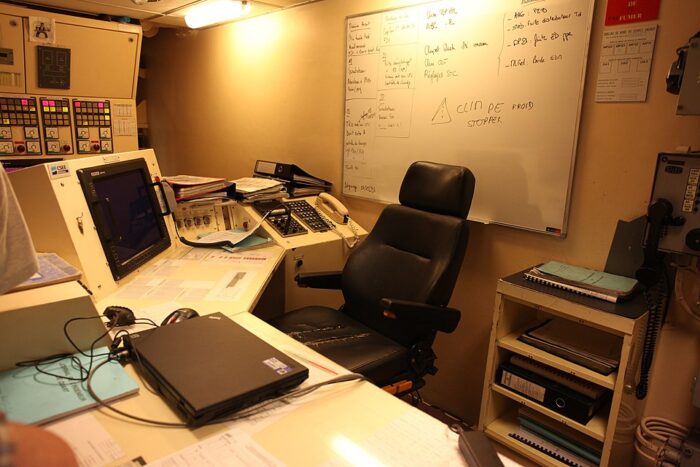
One of the great novelty of the design for these Frigates, was to adopt an all-diesel powerplant. This is traduced by four diesel SEMT Pielstick 12PA6V280 STC2 rated for a total of 21,000 hp (16,000 kW). The 1948 company was purchased by MAN in 2006. These engines were distributed also by the US under Fairbank-Morse to procure 16-cylinder PC2.5 STC used by the San Antonio-class LPD 17 troop transporters. These diesels are also equipping most French ships, the Georges Leygues, La Fayette, Floréal, Cassard and Horizon class frigates, A69 avisos, P400 patrol boats, Jules Verne repair ship, Durance class oil tankers, Foudre and Ouragan LHDs. So the network for maintenance and repair was well established.
This group enables a top speed of 25 knots (46 km/h; 29 mph) which can seem slow for a long-established 30 knots standard for fleet actions. 30 knots were even in the 1980s considered as an asset to protect against missiles. It was theorized a ship could still attempt to turn and face a missile like it was done in the past with torpedoes, reducing the surface. Speed was also required to hunt down fast Soviet SSNs.
However, the Lafayette were neither designed for high intensity combat, not ASW work as they even lacked a sonar, relying on the helicopter for such surveillance.
These four diesels however were compact, enduring, easy to maintain, provided extra redundancy and constant power, and were easy to replace. There were tanks for 350 t (340 long tons; 390 short tons) of fuel. They also procured a range of 4,000 nmi (7,400 km; 4,600 mi) at 15 knots (28 km/h; 17 mph) or even 9,000 nmi (17,000 km; 10,000 mi) at 12 knots (22 km/h; 14 mph) which enabled a transit on any corner of the globe and extensive French EEZ with few stops.
The Endurance was also limited to 50 days based on the food on board and 60 t (59 long tons; 66 short tons) of potable water for a crew of 164 in normal conditions, which can be extended to around 6 additional personnel on Courbet, La Fayette and Aconit after upgrade. The ships are highly automated.
Protection
As stated above, this starts by stealth features to prevent detection in the first place, reduced noise and heat signatures.
Then the passive hard protection comes in composite panelling of kevlar over sensitive areas, ammunition magazine and the control centre.
Active protection consists in the following:
-Two Dagaie Mk2 AMGL-1C chaff launcher.
-CANTO anti-torpedo countermeasure system (fitted La Fayette 2021-22, Aconit in 2023, Courbet 2025)
-AN/SLQ-25 Nixie tugged noise maker
-Prairie-Masker noise reduction system
Armament
100 mm TR automatic gun
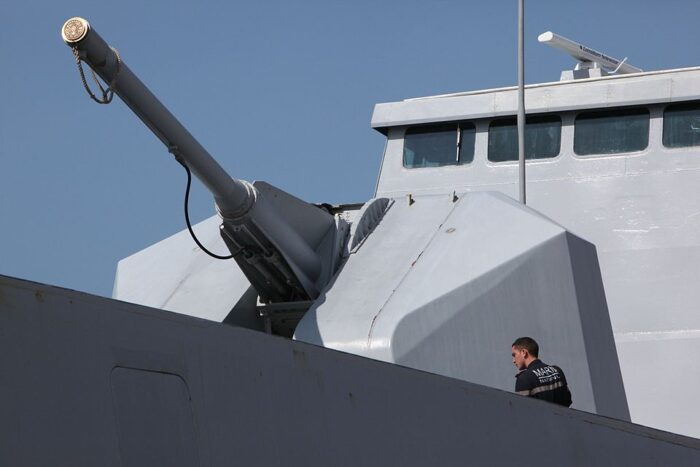
Last in a long line started in 1949, in service on virtually all French ships (and others) in the cold war. Dual purpose.
The modèle 100 TR was developed for the Lafayette class with a new turret shape, derivative of the 68 CADAM standard for 78 rpm.
Specs:
22t, 55 cal. 5.5m or 220 inches long. Full automation.
Shell 100x700mmR 13.5 kgs (30 lb), cartridge 23.6 kilograms (52 lb)
Elevation 29°/s, traverse 40°/s, 78-90 rpm at MV 870 m/s (2,900 ft/s)
Effective range 17,000 m, 12,000 m against surface targets.
20 mm modèle F2 guns
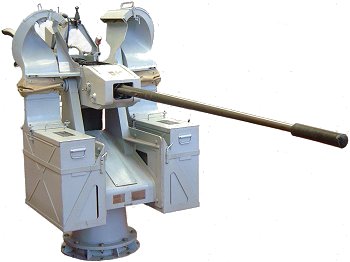 Long derivative of the Hispano-Suiza, used to deal with asymetric threats. Single operator.
Long derivative of the Hispano-Suiza, used to deal with asymetric threats. Single operator.
Specs:
Mass: 332 kg (732 lb) wt ammo, 2,600 mm (100 in) long, barrel 1,970 mm (78 in)
Autocannon with Gas unlocking, delayed blowback, elevation −15° to + 65°, 900 rpm
Shells 20×139mm at 1,050 m/s (3,400 ft/s), range 1,500 m (4,900 ft).
Exocet MM40 block II
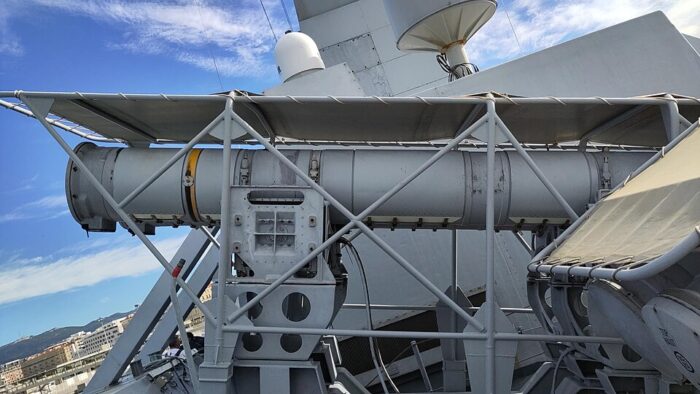
Eight canisters in two blocks of four angled up on the intermast platform amidship, facing port and starboard at 90°.
The MM40 is a known beast of burden of French anti-ship ordnance. The Block 3c was adopted after refit by Courbet, La Fayette and Aconit.
Block 3C specs:
530 kgs, 4.7m 350 mm.
Insensitive payload 165 kg (364 lb) HE blast with pre-fragmented effects, impact fuze, proximity.
Single jettisoned rocket booster at launch, turbojet engine.
250 km range and Mach 0.9.
3D way-points navigation hybrid INS/GNSS, radar altimeter for automated sea skimming
Terminal: Advanced J-band active RF seeker with adaptive search patterns with selectivity and ECCM.
Crotale CN2 CIWS
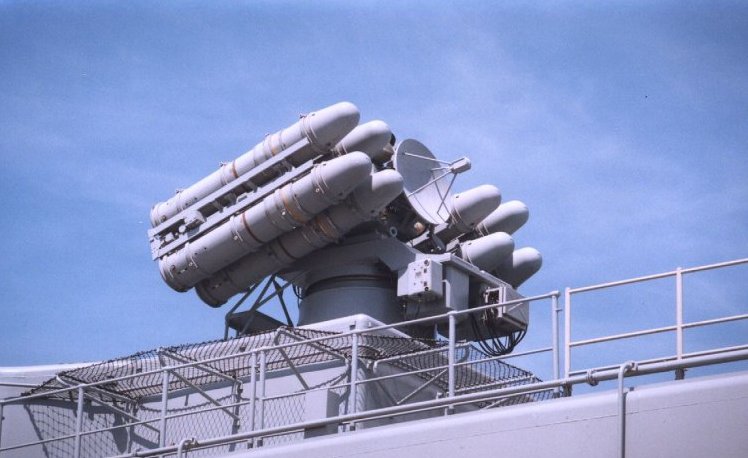
R440 SAM, single launcher with eight canisters, four per wing, installed adop the hangar aft. Operational 11 km, ceiling 6,000 m. 13 kgs warhead, IF seeking, prox. fuse.
Sadral Launchers
Smaller MANPADS twin-arm, three each (six missiles) single operator launcher. Fires the Mistral Mk 3 SAM/SSM and replaced Crotale on Courbet, La Fayette and Aconit after refit.
The Mistral weights 19.7 kg for 1.86 m long plus initial booster, 90 mm wide, with a 8 km range effective and carrying a 2.95 kg warhead with HE, high density tungsten balls
Uses laser proximity or impact triggered? Powered by a solid Rocket Motor, 2-stage at max altitude 6 km and 930 m/s (Mach 2.71).
Simbad Launcher
Same missile but with a twin arm launcher, used on Surcouf from 2023 in place of the Crotale.
Sensors
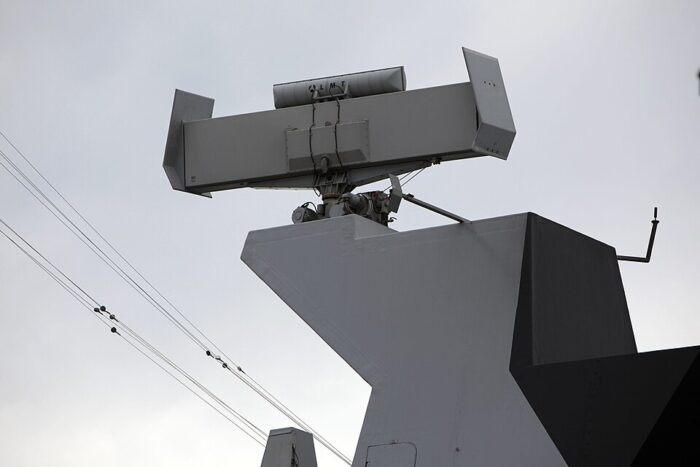
1 × DRBN34 navigation radar
1 × DRBN34 landing radar
1 × Air/Surface DRBV 15C sentry radar
1 × Thales TAVITAC CMS-1 (fitted to Surcouf and Guépratte)
1 x Thales TAVITAC CMS-2 (La Fayette, Courbet, Aconit)
1 × SENIT FLF combat management system (replacing both systems in all ships later)
1 × firing control radar, 100 mm gun
1 × CN2 firing control radar (20 mm and 100 mm)
1 × Saïgon ARBG 1 radio interceptor
1 × ARBR 21 radar interceptor
Initially no sonar was plannned, but given this crucial shortcoming, Surcouf received later a BlueWatcher sonar of limited capabilities.
Courbet, La Fayette and Aconit received instead a KingKlip Mk 2 hull-mounted sonar.
The other layer of ASW protection is provided by the on-board helicopter that can be configured for ASW detection and combat (see below).
Communication suite
1 × Integrated Shipboard Communication System ISCS (SNTI 120 ch.)
1 × SEAO/OPSMER Naval command support system
1 × Syracuse II satellite transmission system
1 × Inmarsat navigation system
Air Group
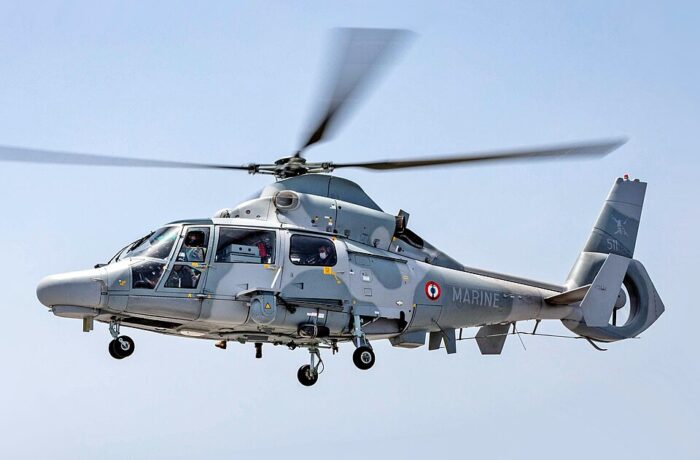
A hangar was fitted aft for a medium-sized helicopter of the SA342 Panther or NH90 type. The single-door hangar has enough room above and on both sides to house spare engines and parts, with a gantry crane for full disassembly and maintenance at sea. In addition, there is an 80 m3 (2,800 cubic ft) kerosene tank. The Panther is a 1984 Aéospatiale derivative of the AS365 Dauphin maritime helicopter, mostly used for SAR. The Panther was designed for ASW and naval combat, with a land version capable of antitank work. Largely exported, it was updated with more powerful sensors, better engines, greater performances across the board, declined into 18 versions.
Specs
Top speed: 306 km/h (190 mph, 165 kn), range 827 km (514 mi, 447 nmi)
Endurance 4.1 hours, ceiling 5,865 m (19,242 ft), climb rate 8.9 m/s (1,750 ft/min)
Armament Mk46 or Whitehead A.244/S anti-submarine warfare torpedoes, VDS and MAD detector, buoys.
The Eurocopter NH90 is a much larger beast with even greater ASW capabilities. Both are also usable for SAR work id needed.
⚙ specifications |
|
| Displacement | 3,200 t (3,100 long tons) standard, 3,800 t (3,700 long tons) FL |
| Dimensions | 125 x 15.4 x 4.1 m (410 ft 1 in x 50 ft 6 in x 13 ft 5 in) |
| Propulsion | 4 diesel SEMT Pielstick 12PA6V280 STC2: 21,000 hp (16,000 kW) |
| Speed | 25 knots (46 km/h; 29 mph) |
| Range | 350t fuel: 9,000 nmi (17,000 km; 10,000 mi) at 12 kts (22 km/h; 14 mph) |
| Armament | 100 mm TR gun, 2× 20 mm F2, 2×4 Exocet SSM, Crotale CN2/Sadral(Mistral) SAM, se notes |
| Sensors | DRBN34, DRBN34, DRBV 15C, TAVITAC CC/SENIT FLF CMS, CN2 FCS, ARBG 1/ARBR 21, Dagaie, CANTO ECM, see notes |
| Protection | Kevlar on ammo magazine and CC. |
| Air Group | 1x Panther or NH90 |
| Extras | 2× ETN boats |
| Crew | 164+(6) |
Career of
 La Fayette (F 710)
La Fayette (F 710)
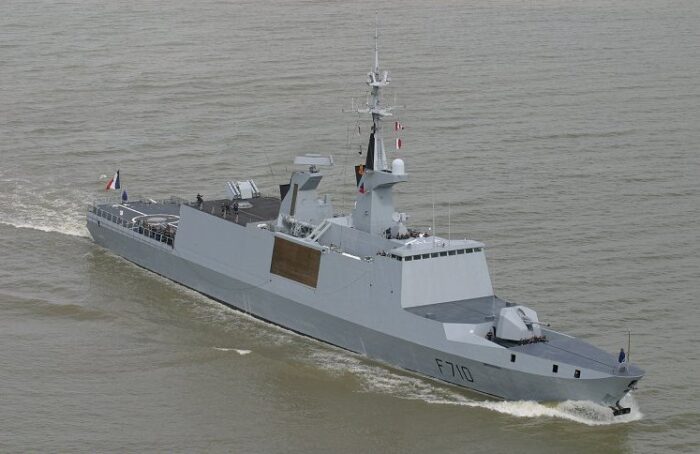
F710 La Fayette was the lead vessel, laid down at DCN Lorient, launched on 13 June 1992 and completed on 22 March 1996. La Fayette appeared in 1997 James Bond Goldeneye, but the movie was shot in 1996 when she was still training on many systems since March. She started a major life extension upgrade in October 2021 to prolongate her to the late 2030s with a new hull-mounted sonar, improved point air defence systems, CANTO anti-torpedo system, and Exocet Mark 3C. She made her sea trials by May 2022, and reached full operational status by November 2022 Scheduled for replacement by 2031. By February 2023, she started a round the world deployment with the LHD Dixmude, now allowed by her refit. She was back in Toulon in July.
In 2024, she was deployed in the Atlantic to replace the Premier-Maître L’Her before being relieved by Amiral Ronarc’h, the first FDI commissioned.
 Surcouf (F 711)
Surcouf (F 711)
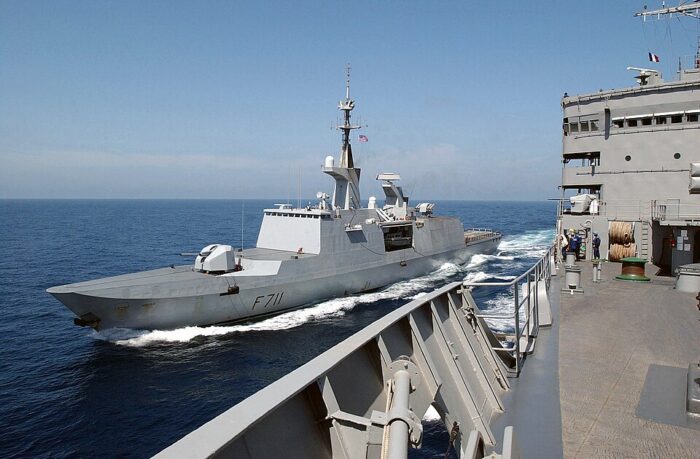
F 711 was launched at DCN on 3 July 1993, and completed on 7 February 1997. On 14 May 2001, Surcouf she rendered assistance to the skipper a racing catamaran which starboard hull was seriously damaged. The crew was airlifted to safety by her helicopter. On 14 October 2004, she assisted the Panamanian cargo Sara 2 which ran aground near Yemen, airlifting her whole 16-man crew, later transferred to the Yemeni coast guard. On 17-21 May 2008, she took part in Exercise KhunjarHaad in the Gulf of Oman with USS Russell, HMS Montrose, and RFA Wave Knight for anti-piracy operations, including search and seizure (VBSS) and interoperability. In November 2012 she was again at the Horn of Africa and operated a British Lynx HMA.8 helicopter of 815 Squadron over her 4-month deployment with RN personal, including 2 Royal Marine snipers. This was in the wake of a new military resources sharing between France and UK for joint Ops. In her 2017–18 refit she was the first to receive the Thales Bluewatcher sonar. In 2021, she was in the Pacific with the LHD Tonnerre.
In April 2022, she had a Panther helicopter on board for her Indian Ocean deployment, relieving Guépratte. On 26-30 May she trained with the Kuwait Naval Force.
In October 2023 she was in the Eastern Mediterranean as the Gaza war flared up, escorting the LHD Tonnerre and frigate Alsace.
She started a limited structural and technical upgrade to be re-assigned to offshore patrol duties before a planned withdrawal in 2027 but she was maintained for a few more years despite not receiving her midlife upgrade. She will be replaced by one FDI Frigate at an unknown date. To be updated.
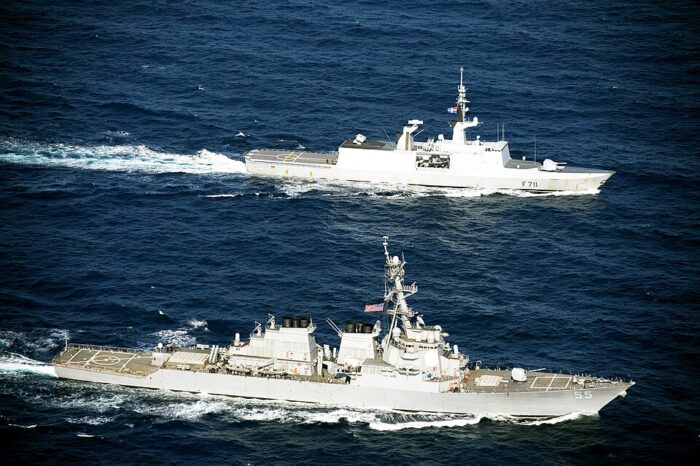
 Courbet (F 712)
Courbet (F 712)
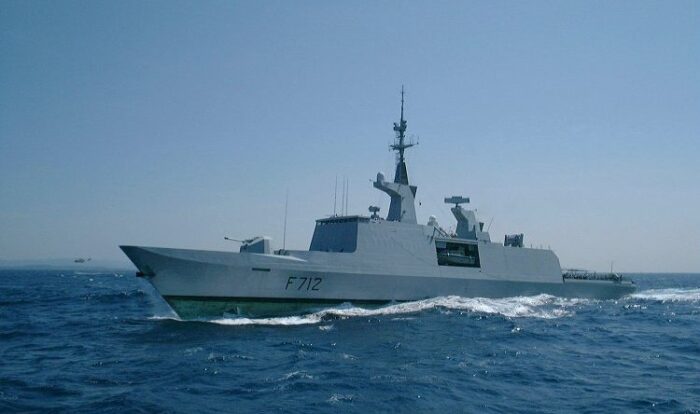
Courbet in heavy seas, showing her absence of hull sonar and green primer for her hull underbelly, adapted to the med and tropical waters.
F 712 was launched on 12 March 1994 and completed on 1 April 1997. She took part in Operation Baliste. During it, on 3 October 2006, an Israeli fighter penetrated her 2-nautical-mile (4 km) defence perimeter without answering to radio calls, triggering a diplomatic incident. In September, she took part in the anti-piracy campaign off Somalia, recapturing a yacht from pirates on 2 September. In December 2009 she escorted Jeanne d’Arc on her final voyage after a career of 46 years round the world, ending by May 2010.
In the Libyan Civil War on 29 April 2011 she found and engaged 4 loyalist RHIBs boats laying mines, sinking one, repelling the others.
In June 2020, while controlling arms smuggling to Libya, she claimed to be illuminated by a Turkish frigate’ fire control radar.
On her first operational deployment after a midlife upgrade she was in the Gulf of Guinea with the LHD Mistral, seizing 2 tons of drugs in May 2022.
In September 2023, she suffered a firer while in the Mediterranean and had to be returned to Toulon for repair, back at sea in February 2024.
She had the first midlife upgrade of her class, from October 2020 (hull-mounted sonar, improved point air defence, latest Exocet and upgraded sensors and CiC). She had her post-refit trials from June 2021, projected to remain in service until 2032. The CANTO anti-torpedo countermeasures system is placed for 2025. To be updated.
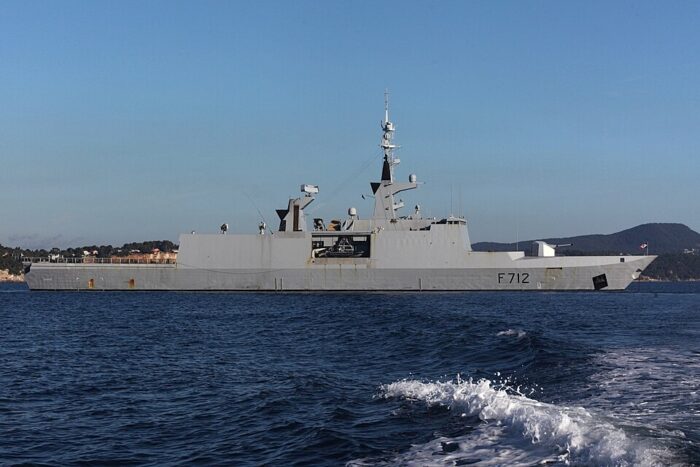
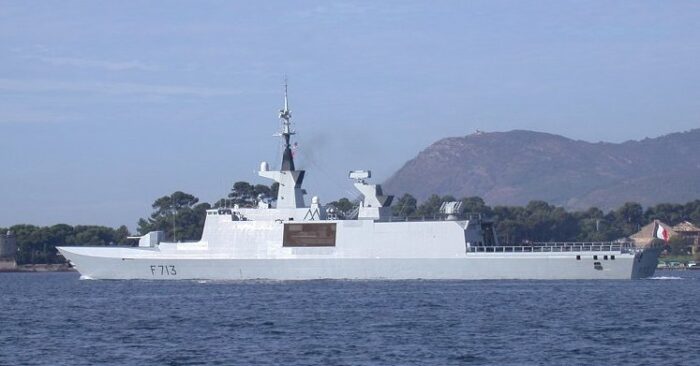
 Aconit (F 713)
Aconit (F 713)
F 713 was launched on 8 June 1997 and completed on 3 June 1999. Aconit took part in the action of 9 April 2009, a raid off Somalia conducted by France and Germany to retake the French yacht Tanit, as part of Operation Atalanta anti-piracy operations. Based in Toulon, she was part of the Mediterranean fleet since the start and by October 2021, took part in the Mare Aperto exercises with the Italian Navy. In September 2022, she was deployed to the Indian Ocean for exercises with the Egyptian Navy (which purchased the ex-Russian LHDs of the Mistral class). From November 25 to December 8, she took part in “Pearl of the West” exercises with the United Arab Emirates and Kuwaiti navies. She was back home on 22 December 2022.
Her major life extension upgrade started by February 2023 (hull-mounted sonar, new SAMs, CANTO ATCS, latest Exocet, electronics and software upgrades). She left the dry dock July and fully operational by October with another career from 2024 to 2034. Also scheduled for replacement by an FDI frigate. To be updated in the future.
 Guépratte (F 714)
Guépratte (F 714)
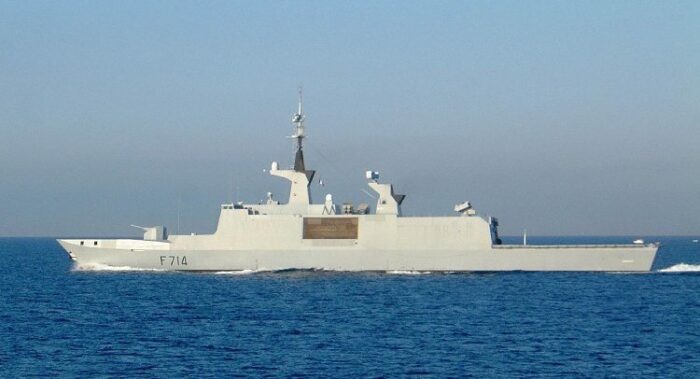
F 714 was launched on 3 March 1999 and completed on 27 October 2001. She became the first French frigate with an important complement of women, 25 female crewmen on board, testing new facilities to be ported on other ships. From January 2016, she was commanded by the first French female commander in the Marine Nationale. The same year she took part in the “Jeanne d’Arc battle group” with the LHD Tonnerre. By early 2022, she was in the Indian Ocean, returned in May, relieved by Surcouf. She returned in the Arabian Sea in late 2022 to take place in Combined Task Force (CTF) 150, sizing a lot of hashish and heroin from a fishing vessel. By early 2023, the press leaked about a supposed boarding and seizure of an Iranian vessel carrying thousands of assault rifles and TGMs to Yemen. She was back in Toulon in March 2023. In 2024, she escorted the LHD Tonnerre for an ew Jeanne D’Arc mission around America and North America.
Budget restriction prevented the hull-mounted sonar upgrade, and she is going to have a modest structural and technical upgrade, then re-assigned to offshore patrol duties with a planned withdrawal in 2031. No midlife upgrade is still planned to this day. To be updated in the future.
Exports
Al Riyadh class
The three Al Riyadh-class class frigates were developed as a heavily modified version placing the focus on AA defence, larger and as a result reaching 4,700 tonnes (4,600 long tons; 5,200 short tons) by receiving extra modules which stretched them to 133 m (436 ft 4 in) overall. Their combat system was from Armaris, a DCN/Thales joint venture to operate the Aster 15 missile, in a DCN SYLVER VLS launcher. This is complemented by Exocet SSMs. The main gun was changed for a faster firing but smaller Oto Melara 76 mm/62 Super Rapido. Also were added four 533 mm (21.0 in) aft torpedo tubes operating the DCNS F17 heavyweight anti-submarine torpedo. Speed was about the same at 24.5 knots (45.4 km/h; 28.2 mph) for a range of 7,000 nautical miles (13,000 km; 8,100 mi) better suited for the red and Arabian seas sea. For more, see Saudi Arabia. Dedicated article planned in 2026.
 FF 812 Al Riyadh
FF 812 Al Riyadh
Laid down on 28 May 1999 at DCN, Launched on 1 August 2000 and Commissioned on 26 July 2002, homeported to King Faisal Naval Base.
 FF 814 Makkah
FF 814 Makkah
Laid down 24 July 2001 at Direction des Constructions Navales, Lorient, Launched on 7 September 2002, Commissioned on 23 October 2004, now at King Faisal Naval Base.
 FF 816 Al Damman
FF 816 Al Damman
Laid down at DCN on 8 August 2000, Launched on 20 July 2001 and Commissioned on 3 April 2004, Homeport King Faisal Naval Base.
Kang Ding class
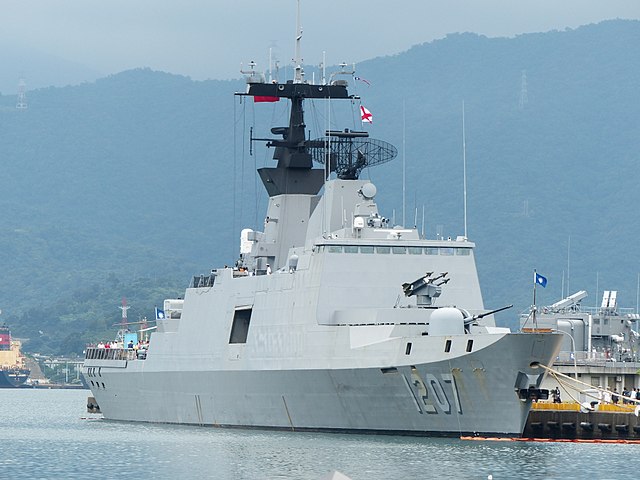
The Republic of China was put in a conundrum in the 1990s as the US tried to improve its relations with China, a move started in the 1987s and slowed down its deliveries to Taiwan, no longer recognized. To ensure the defence of the Taiwan Strait, the Republic of China (Taiwan) wanted a state-of-the-art ship that can tackle the presence of Chinese submarines in its waters, and acquire a dedicated new anti-submarine warfare frigate. An international bid was won by France with a contract of US$1.75 billion in the early 1990s. They were all built at DCNS. These were modified Lafayette class, but less extensively than the Saudi ones, and ships configured for ASW and surface attack. The Exocet were replaced by Hsiung Feng II SSM, with Sea Chaparral for air defence. The main gun however was an Oto Melara 76 mm/62 mk 75 identical to the Singaporean Formidable-class. Integration of systems proved a bit complicated. In the hangar is hosted a Sikorsky S-70C(M)-1/2 ASW helicopter.
In 2021 the Kang Ding class was announced to be upgraded with a new SAM, the Sky Sword II and Sky Bow III as the battle system, possibly of US manufacture. Top speed the same 25 knots (46 km/h; 29 mph), range 4,000 nmi (7,400 km; 4,600 mi). In complement to the OTO gun, which rate of fire was improved, she has two Phalanx CIWS and two Bofors 40mm L70 as complement.
See also the ROCN page for updates.
 PFG-1202 Kang Ding
PFG-1202 Kang Ding
PFG-1202 Kang Ding (康定) was laid down at DCNS in 1993, launched on 22 March 1994 and completed on 24 May 1996. Active, modernized 2021.
 PFG-1203 Si Ning
PFG-1203 Si Ning
PFG-1203 Si Ning (西寧) was laid down in 1994, launched on 5 November 1994 and commissioned on 5 October 1996.
 PFG-1205 Kun Ming
PFG-1205 Kun Ming
PFG-1205 Kun Ming (昆明) was laid down on 1994, launched on 13 May 1995 and commissioned on 26 February 1997.
 PFG-1206 Di Hua
PFG-1206 Di Hua
PFG-1206 Di Hua (迪化) was laid down on 1995, launched on 27 November 1995 and commissioned on 14 August 1997.
 PFG-1207 Wu Chang
PFG-1207 Wu Chang
PFG-1207 Wu Chang (武昌) was laid down on 1995, launched on 27 November 1995 and commissioned on 16 December 1997.
 PFG-1208 Chen De
PFG-1208 Chen De
PFG-1208 Chen De (承德) was laid down on 1995, launched on 2 August 1996 and commissioned on 19 March 1998.
Formidable class
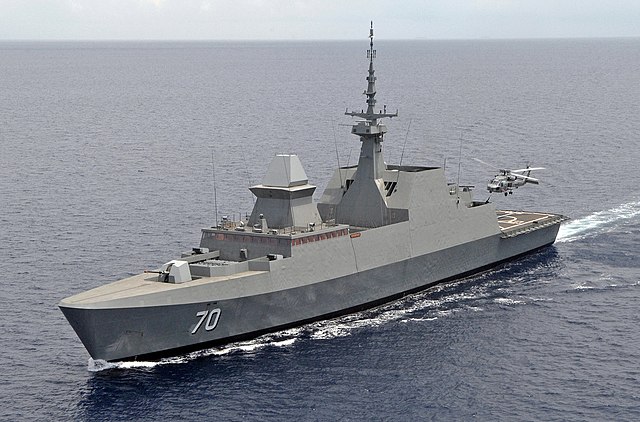
The Republic of Singapore Navy was the last customer of the Lafayette class, acquiring the six Formidable-class frigates, about the same size to the La Fayette but wt a completely new armament and appearance. They were designed as versatile ships, very well armed, with Boeing Harpoon missiles and a stealthy last-gen super rapido Oto Melara 76 mm as well as a SYLVER launcher/Aster missile combination in a VLS. RSS Formidable, was built by DCN but a transfer tech. contract enabled the rest of the class to be built by Singapore Technologies Marine. In the hangar takes place two S-70B Seahawk helicopters, enhancing the ASW capabilities. The powerplant was also boosted to reach 27 kn (50 km/h; 31 mph) for a range of 4,200 nmi (7,800 km; 4,800 mi).
The full arsenal comprises 8 (Up to 24) RGM-84C Harpoon SSM, two Sylver A50 8-cell VLS, MBDA Aster 15/30, 2× Sylver A43 8-cell VLS MBDA Aster 15.
Two B515 triple tubes with reloads, EuroTorp A244/S Mod 3 torpedoes. Guns: Oto Melara 76mm Super Rapido gun, 4× STK 50MG 12.7 mm (0.50 in) HMG, 2× 25mm Mk 38 Mod2 Typhoon Weapon Station.
The Formidable also comes with the Long-Range Acoustic Device 500 Xtreme (LRAD500X), a Thales Herakles scanned array radar, Thales STING EO Mk2 FCR, Terma Electronic Scanter 2001 navR, and EDO Model 980 active low frequency towed sonar (ALOFTS). It is protected by the RAFAEL C-PEARL-M, 3 Sagem Dagaie DL, Leonardo Finmeccanica Morpheus anti-torpedo suite (2 WASS C310 launchers).
See the Singaporean page for updates.
 RSS Formidable
RSS Formidable
FF 68 Formidable was laid down at DCNS in 2002, launched on 7 January 2004 and commissioned on 5 May 2007.
 RSS Intrepid
RSS Intrepid
RSS Intrepid FF 69 was laid down at ST Engineering, launched on 3 July 2004 and completed in 5 February 2008.
 RSS Steadfast
RSS Steadfast
RSS Steadfast FF 70 was launched at 28 January 2005 and completed on 5 February 2008.
 RSS Tenacious
RSS Tenacious
RSS Tenacious FF 71 was launched on 15 July 2005 and completed on 5 February 2008.
 RSS Stalwart
RSS Stalwart
RSS Stalwart FF 72 was launched on 9 December 2005 and completed on 16 January 2009.
RSS Supreme FF 73 was launched on 9 May 2006 and completed (Commisssioned) on 16 January 2009.
Read More/Src
Books
Flottes de combat Edition 1996 – Bernard Prézelin
Conway’s all the world’s fighting ships 1947-1995
Jordan, John; Moulin, Jean (2021). “The ‘Stealth’ Frigates of the La Fayette Class”. In Jordan, John (ed.). Warship 2021. Oxford, UK: Osprey Publishing.
Links
seaforces.org/ F-710 FS La Fayette
en.wikipedia.org La Fayette class frigate
fr.wikipedia.org/ Classe_La_Fayette
web.archive.org netmarine.net/
mbda-systems.com
commons.wikimedia.org/ Category:Surcouf_(F711)
naval-technology.com lafayette/
web.archive.org netmarine.net/
navalnews.com mission-jeanne-darc-2023
navalnews.com first-upgraded La Fayette
navalnews.com/ canto anti torpedo system australia
navalnews.com euronaval 2020
armyrecognition.com france accelerates fdi frigates
armyrecognition.com archives-naval-defense
navalnews.com/ euronaval-2022 new decoy launcher
meretmarine.com/ la fregate la fayette operationnelle apres renovation
naval-news taiwan to upgrade la fayette frigates
naval-technology.com al_riyadh/
alabordache.com/ fregate_rang_2
Videos
Model Kits
3D
3dmodels.org * cults3d.com * 3dmodels.org * cdn.renderhub.com

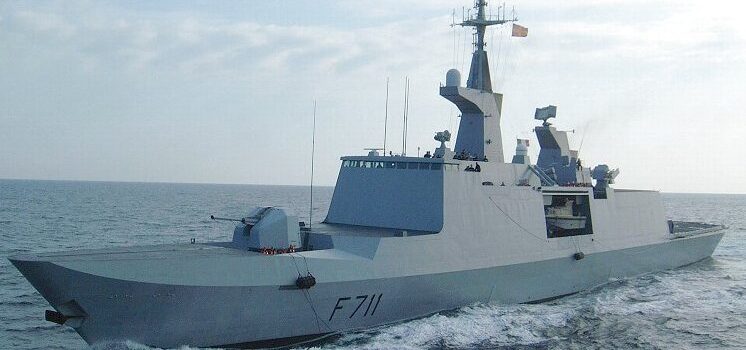

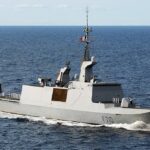
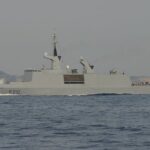
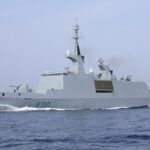
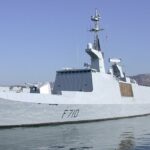
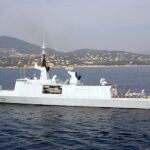
 Latest Facebook Entry -
Latest Facebook Entry -  X(Tweeter) Naval Encyclopedia's deck archive
X(Tweeter) Naval Encyclopedia's deck archive Instagram (@navalencyc)
Instagram (@navalencyc)





 French Navy
French Navy Royal Navy
Royal Navy Russian Navy
Russian Navy Armada Espanola
Armada Espanola Austrian Navy
Austrian Navy K.u.K. Kriegsmarine
K.u.K. Kriegsmarine Dansk Marine
Dansk Marine Nautiko Hellenon
Nautiko Hellenon Koninklije Marine 1870
Koninklije Marine 1870 Marinha do Brasil
Marinha do Brasil Osmanlı Donanması
Osmanlı Donanması Marina Do Peru
Marina Do Peru Marinha do Portugal
Marinha do Portugal Regia Marina 1870
Regia Marina 1870 Nihhon Kaigun 1870
Nihhon Kaigun 1870 Preußische Marine 1870
Preußische Marine 1870 Russkiy Flot 1870
Russkiy Flot 1870 Svenska marinen
Svenska marinen Søværnet
Søværnet Union Navy
Union Navy Confederate Navy
Confederate Navy Armada de Argentina
Armada de Argentina Imperial Chinese Navy
Imperial Chinese Navy Marinha do Portugal
Marinha do Portugal Mexico
Mexico Kaiserliche Marine
Kaiserliche Marine 1898 US Navy
1898 US Navy Sovietskiy Flot
Sovietskiy Flot Royal Canadian Navy
Royal Canadian Navy Royal Australian Navy
Royal Australian Navy RNZN Fleet
RNZN Fleet Chinese Navy 1937
Chinese Navy 1937 Kriegsmarine
Kriegsmarine Chilean Navy
Chilean Navy Danish Navy
Danish Navy Finnish Navy
Finnish Navy Hellenic Navy
Hellenic Navy Polish Navy
Polish Navy Romanian Navy
Romanian Navy Turkish Navy
Turkish Navy Royal Yugoslav Navy
Royal Yugoslav Navy Royal Thai Navy
Royal Thai Navy Minor Navies
Minor Navies Albania
Albania Austria
Austria Belgium
Belgium Columbia
Columbia Costa Rica
Costa Rica Cuba
Cuba Czechoslovakia
Czechoslovakia Dominican Republic
Dominican Republic Haiti
Haiti Hungary
Hungary Honduras
Honduras Estonia
Estonia Iceland
Iceland Eire
Eire Equador
Equador Iran
Iran Iraq
Iraq Latvia
Latvia Liberia
Liberia Lithuania
Lithuania Mandchukuo
Mandchukuo Morocco
Morocco Nicaragua
Nicaragua Persia
Persia San Salvador
San Salvador Sarawak
Sarawak Uruguay
Uruguay Venezuela
Venezuela Zanzibar
Zanzibar Warsaw Pact Navies
Warsaw Pact Navies Bulgaria
Bulgaria Hungary
Hungary

 Bundesmarine
Bundesmarine Dutch Navy
Dutch Navy Hellenic Navy
Hellenic Navy Marina Militare
Marina Militare Yugoslav Navy
Yugoslav Navy Chinese Navy
Chinese Navy Indian Navy
Indian Navy Indonesian Navy
Indonesian Navy JMSDF
JMSDF North Korean Navy
North Korean Navy Pakistani Navy
Pakistani Navy Philippines Navy
Philippines Navy ROKN
ROKN Rep. of Singapore Navy
Rep. of Singapore Navy Taiwanese Navy
Taiwanese Navy IDF Navy
IDF Navy Saudi Navy
Saudi Navy Royal New Zealand Navy
Royal New Zealand Navy Egyptian Navy
Egyptian Navy South African Navy
South African Navy






























 Ukrainian Navy
Ukrainian Navy dbodesign
dbodesign